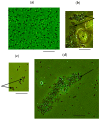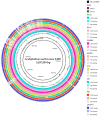Unraveling the Central Role of Sulfur-Oxidizing Acidiphilium multivorum LMS in Industrial Bioprocessing of Gold-Bearing Sulfide Concentrates
- PMID: 34062882
- PMCID: PMC8147356
- DOI: 10.3390/microorganisms9050984
Unraveling the Central Role of Sulfur-Oxidizing Acidiphilium multivorum LMS in Industrial Bioprocessing of Gold-Bearing Sulfide Concentrates
Abstract
Acidiphilium multivorum LMS is an acidophile isolated from industrial bioreactors during the processing of the gold-bearing pyrite-arsenopyrite concentrate at 38-42 °C. Most strains of this species are obligate organoheterotrophs that do not use ferrous iron or reduced sulfur compounds as energy sources. However, the LMS strain was identified as one of the predominant sulfur oxidizers in acidophilic microbial consortia. In addition to efficient growth under strictly heterotrophic conditions, the LMS strain proved to be an active sulfur oxidizer both in the presence or absence of organic compounds. Interestingly, Ac. multivorum LMS was able to succeed more common sulfur oxidizers in microbial populations, which indicated a previously underestimated role of this bacterium in industrial bioleaching operations. In this study, the first draft genome of the sulfur-oxidizing Ac. multivorum was sequenced and annotated. Based on the functional genome characterization, sulfur metabolism pathways were reconstructed. The LMS strain possessed a complicated multi-enzyme system to oxidize elemental sulfur, thiosulfate, sulfide, and sulfite to sulfate as the final product. Altogether, the phenotypic description and genome analysis unraveled a crucial role of Ac. multivorum in some biomining processes and revealed unique strain-specific characteristics, including the ars genes conferring arsenic resistance, which are similar to those of phylogenetically distinct microorganisms.
Keywords: Acidiphilium multivorum; acidophilic microbial communities; arsenic resistance; biooxidation; gold-bearing sulfide concentrates; sulfur metabolism.
Conflict of interest statement
The authors declare no conflict of interest.
Figures






Similar articles
-
In silico genome analysis of an acid mine drainage species, Acidiphilium multivorum, for potential commercial acetic acid production and biomining.J Environ Sci Health B. 2020;55(5):447-454. doi: 10.1080/03601234.2019.1710985. Epub 2020 Jan 15. J Environ Sci Health B. 2020. PMID: 31941390
-
Genomic Analysis Unravels Reduced Inorganic Sulfur Compound Oxidation of Heterotrophic Acidophilic Acidicaldus sp. Strain DX-1.Biomed Res Int. 2016;2016:8137012. doi: 10.1155/2016/8137012. Epub 2016 Apr 28. Biomed Res Int. 2016. PMID: 27239474 Free PMC article.
-
[Thermoacidophilic micirobial community oxidizing the gold-bearing flotation concentrate of a pyrite-arsenopyrite ore].Mikrobiologiia. 2014 Sep-Oct;83(5):552-64. Mikrobiologiia. 2014. PMID: 25844467 Russian.
-
From Genes to Bioleaching: Unraveling Sulfur Metabolism in Acidithiobacillus Genus.Genes (Basel). 2023 Sep 8;14(9):1772. doi: 10.3390/genes14091772. Genes (Basel). 2023. PMID: 37761912 Free PMC article. Review.
-
Sulfur Oxidation in the Acidophilic Autotrophic Acidithiobacillus spp.Front Microbiol. 2019 Jan 10;9:3290. doi: 10.3389/fmicb.2018.03290. eCollection 2018. Front Microbiol. 2019. PMID: 30687275 Free PMC article. Review.
Cited by
-
Microbes of biotechnological importance in acidic saline lakes in the Yilgarn Craton, Western Australia.Front Microbiol. 2024 Feb 14;15:1308797. doi: 10.3389/fmicb.2024.1308797. eCollection 2024. Front Microbiol. 2024. PMID: 38419638 Free PMC article.
-
The Evaluation of Bacterial Abundance and Functional Potentials in the Three Major Watersheds, Located in the Hot Spring Zone of the Tatun Volcano Group Basin, Taiwan.Microorganisms. 2022 Feb 23;10(3):500. doi: 10.3390/microorganisms10030500. Microorganisms. 2022. PMID: 35336075 Free PMC article.
-
Acidophilic heterotrophs: basic aspects and technological applications.Front Microbiol. 2024 May 17;15:1374800. doi: 10.3389/fmicb.2024.1374800. eCollection 2024. Front Microbiol. 2024. PMID: 38827148 Free PMC article. Review.
References
-
- Harrison A.P., Jr. Acidiphilium cryptum gen. nov., sp. nov., heterotrophic bacterium from acidic mineral environments. Int. J. Syst. Evol. Microbiol. 1981;31:327–332. doi: 10.1099/00207713-31-3-327. - DOI
-
- Wakao N., Nagasawa N., Matsuura T., Matsukura H., Matsumoto T., Hiraishi A., Matsumoto T., Hiraishi A., Sakurai Y., Shiota H. An acidophilic chemoorganotrophic bacterium from pyritic acid mine drainage. J. Gen. Appl. Microbiol. 1994;40:143–159. doi: 10.2323/jgam.40.143. - DOI
-
- Hiraishi A., Nagashima K.V.P., Matsuura K., Shimada K., Takaichi S., Wakao N., Katayama Y. Phylogeny and photosynthetic features of Thiobacillus acidophilus and related acidophilic bacteria: Its transfer to the genus Acidiphilium as Acidiphilium acidophilum comb. nov. Int. J. Syst. Bacteriol. 1998;48:1389–1398. doi: 10.1099/00207713-48-4-1389. - DOI - PubMed
Grants and funding
LinkOut - more resources
Full Text Sources

